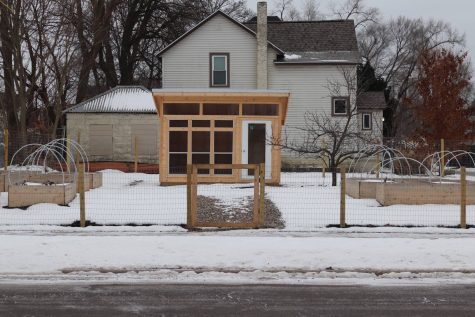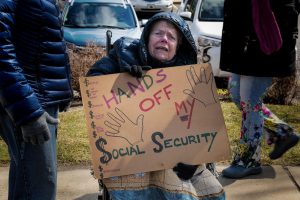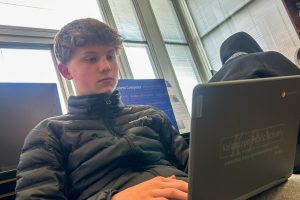Community independence in agriculture is vital to tackle food insecurity for Kalamazoo residents
Credit: August Crothers
The crops and equipment in the Hoop House are protected from the weather in the greenhouse structure, due to this, the Hoop House can continue to grow food and hold events into the winter. The white board is used as a calendar for events and dates along with holding important information about the garden.
January 28, 2022

Students pour into the cafeteria during lunch periods waiting for the doors to open, ready to eat whatever is served that day. For many, school-provided lunch and breakfast is their only source of reliable food. Accessible, free lunch at school helps families by freeing up money, that would be spent on breakfast or lunch, for other food or other necessary expenses.
Students had a difficult time getting food during online school. Although services like the Summer Food Service Program alleviated the strain on families, many families still face difficulties getting lunch. This year Kalamazoo Public Schools has begun free lunch for all students, making it much easier to get access to that food.
One of the reasons families and individuals face difficulties accessing food is due to what is referred to as food deserts, areas where residents don’t have reliable or easy access to healthy foods due to distance and/or income. Kalamazoo has seen food deserts in low income areas like Edison, the Northside, and downtown Kalamazoo.
The formation of these areas can largely be traced back to white flight when, starting in the 1950s, many Americans would move out to the newly constructed suburbs of post-war America. Oftentimes black people were barred from purchasing homes due to discriminatory business practices and intimidation for the goal of maintaining a “good” neighborhood.
Practices like these, along with the movement of jobs and, in turn, wealth out of urban areas, served to create a pattern of black people being disproportionately represented in low access and low income urban areas. These facts have prompted some to stop using the term “food desert,” like Malik Yakini, the founder of Detroit Black Community Food Security Network, because of its implication of a natural occurrence, that it’s a random chance that there’s no access to food, when in reality it’s the direct effect of deliberate economic practices.
Not only are black people disproportionately affected by food insecurity on the consumer side, but also the producer side.
“Only 1.4% of farmers are black people,” said Kalamazoo Valley Community Farms Coordinator Remi Harrington. “It’s already inherent in the law that you can go and participate in the agricultural ecosystem if you live in a rural community, and in Michigan, rural communities are reflective of the white community. Where black people live, in cities, neighborhoods, and urban centers, we have to spend hundreds of dollars to advocate for ourselves to participate in the industry.”
According to the United States Department of Agriculture (USDA), almost 19 million people in the United States live in low-income or low-access tracts. The pandemic worsened this issue by creating limited service hours for public transport in some areas, along with the economic effects of the pandemic creating more strain on the security of food for many people. Compounding the problem were massive amounts of food being wasted in early 2020, when farmers destroyed perishable food because of the lack of demand as restaurants and schools shut down, despite a high demand for groceries at the time.
Recently, downtown Kalamazoo has been labeled as a place of low-access by experts, like Rachel Bair, the director of sustainable food systems at Kalamazoo Valley Community College. In the last few years, new grocers have opened to close the distance gap between residents of downtown Kalamazoo and grocery stores, including City Centre Market and Deli and Market on Michigan Ave. However, the problem persists.
Over 37,000 people in Kalamazoo County remain in food insecurity. This is due to poverty continuing to be the biggest barrier for many rather than distance. According to Loaves and Fishes, 22% of local households rely on food assistance services, and before school lunch was made free, 70% of students in KPS were eligible for free or reduced lunch.
Community led gardens and community agriculture attempt to bridge this gap and create affordable or free, healthy food. This can include vegetable gardens in urban areas, starting affordable markets in neighborhoods and agriculture education.

A community food initiative that began formally in 2020 is Zoo City Farm, led by Remi Harrington, with the goal to alleviate these issues by encouraging and aggregating urban farms. Zoo City Farm started in the Edison Neighborhood, offering reliable and healthy foods to the residents as a community garden back in 2013. Since this, Zoo City Farm has expanded and now has a space in the Park Trades Center downtown, where they hold classes and workshops on food systems literacy.
Urban farms like these often face zoning challenges.
“There’s not a lack of land in neighborhoods, but actually the right to farm in your neighborhood on properties in residentially zoned areas is something that different municipalities have different perspectives on what’s allowable and what’s not allowable,” Harrington said. “In our community, one of the major feats that we overcame was to be able to get agricultural use variances on the properties I purchased, because they were zoned residential.”
Colleges often have community gardens for students and neighborhood residents, such as Kalamazoo College’s Hoop House. The garden is run by students and Writing Center Director and Mellon Fellow Amy Newday.
“Especially in educational spaces like K College, the temptation is we can sit in classrooms and do a lot of talking about food justice and food sovereignty and how the systems are so screwed up,” Newday continued, “then we all go have lunch and go about our day. To me, part of having that space is having somewhere where we really are asking those questions of ‘well how can we actually do food justice here and now with the resources we have?’”
People who don’t know where their next meal will come from can’t wait for major legislative change; people need to eat today. Until then, gardens like the Hoop House can fill the gap.
“The food grown in the Hoop House goes to a variety of places,” said student team member Maeve Crothers. “Some of it goes to students who are there when the harvesting happens. Some of it goes to the community fridge at the People’s Food Co-op. Some of it goes to other food pantry initiatives, but since the Hoop House is open to all 24/7, we don’t know exactly where all of the food goes.”
Efforts like these are vital for communities to build independence in underserved areas.
Community gardens have precedent in recent American history. “Victory gardens” were household and community gardens utilized during war time to prevent food shortages as lots of food was being diverted to the war effort. During World War II, victory gardens produced around 40% of vegetables in the United States.
A significant increase in food security can be made if more community gardens and other sustainable local agriculture can be cultivated in a similar way as victory gardens, but instead, with the goal of serving underserved communities.
Although fighting for political, legislative and economic change is necessary, fighting to maintain and continue community gardens and community-based resources is the fastest and most reliable way to provide food for those who need it now.











